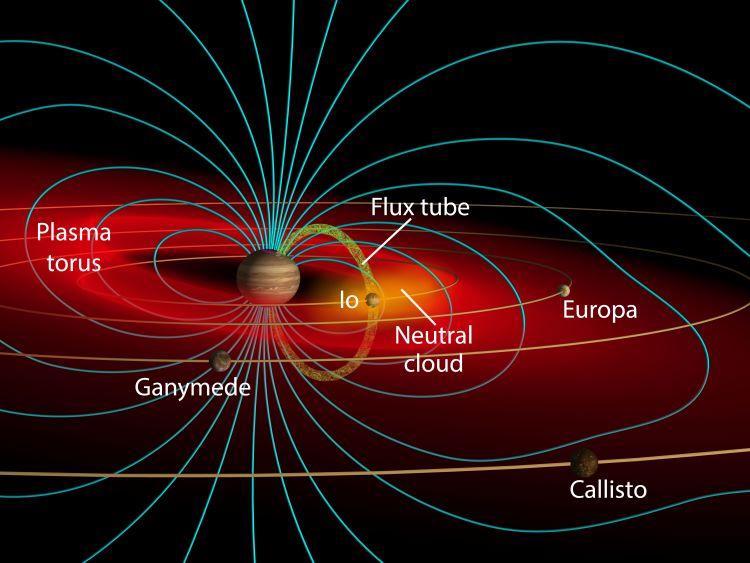The two most powerful space telescopes ever built, NASA’s James Webb Space Telescope (JWST) and Hubble Space Telescope , are about to gather data about the most volcanically body in the entire solar system, Jupiter’s first Galilean Moon, Io . This data will be used in combination with upcoming flybys of Io by NASA’s Juno spacecraft , which is currently surveying the Jupiter system and is slated to conduct these flybys later this year and early 2024. The purpose of examining this small, volcanic moon with these two powerful telescopes and one orbiting spacecraft is for scientists to gain a better understanding of how Io’s escaping atmosphere interacts with Jupiter’s surrounding magnetic and plasma environment.
“The timing of this project is critical,” said Dr. Kurt Retherford , who is a researcher at the Southwest Research Institute (SwRI) and principal investigator of this elaborate science campaign. “Over the next year, Juno will buzz past Io several times, offering rare opportunities to combine in situ and remote observations of this complex system.
We hope to gain new insights into Io’s dramatic volcanism, plasma-moon interactions and the neutral gas and plasma populations that propagate through Jupiter’s vast magnetosphere and trigger intense Jovian auroral emissions. ” Requesting observing time on Hubble is done through NASA’s Hubble Space Telescope Observing Program and is allocated based on the number of orbits that Hubble will be asked to complete around the Earth for a science campaign to complete its research, with each orbit taking approximately 90 minutes. Typically, large observing projects request 75 or more orbits.
This will not be the first time Hubble has examined Jupiter, as it has an extensive history of studying the largest planet in the solar system. Remove All Ads on Universe Today Join our Patreon for as little as $3! Get the ad-free experience for life For this campaign, Dr. Retherford and his team will be using 122 orbits of Hubble around the Earth to gather data on Io for a total time of 183 observing hours, or just over 4.
25 complete orbits of Io around Jupiter, with each orbit taking approximately 42. 5 hours. Additionally, JWST will gather data on Io over the course of 4.
8 hours, or just over 10 percent of one complete orbit of Io around Jupiter. Jupiter’s massive magnetic field is comprised of a giant bubble of charged particles that encircles and swirls around the largest planet in the solar system, of which is comprised primarily of Io’s escaping atmosphere. What has remained a mystery to scientists is the interaction between Io’s atmosphere, surface volatiles, volcanic eruptions, Io’s extended neutral clouds, Jupiter’s ionosphere, and the Io Plasma Torus (IPT), and specifically how to measure and gain greater insights into it.
The IPT is a donut-shaped cloud that encircles Jupiter and is produced from Io’s escaping gases being ionized. “Most of these materials don’t actually escape straight out of the volcanoes but rather are associated with the sublimation of sulfur dioxide frost from Io’s dayside surface,” said Dr. Katherine de Kleer, who is an assistant professor of planetary science and astronomy at Caltech, an expert in JWST data analysis, and one of several co-investigators on this campaign.
“The interaction between Io’s atmosphere and the surrounding plasma provides the escape mechanism for gases released from the moon’s frozen surface. ” After arriving at Jupiter in July 2016, Juno spent its primary science mission studying Jupiter , including its interior, aurorae, and massive magnetosphere. Juno’s extended mission began in August 2021, which is slated to last until September 2025 and has been used to conduct flybys of Jupiter’s Galilean moons , Io, Europa, Ganymede, and Callisto.
For Io, Juno has already conducted flybys in 2022 and earlier this year , with the further close flybys for this new campaign being scheduled for December 30, 2023, February 1, 2024, and September 20, 2024. “The chance for a holistic approach to Io investigations has not been available since a series of Galileo spacecraft flybys in 1999-2000 were supported by Hubble with a prolific 30-orbit campaign,” said Dr. Retherford.
“The combination of Juno’s intensive in situ measurements with our remote-sensing observations will undoubtedly advance our understanding of Io’s role in driving coupled phenomena in the Jupiter system. ” As noted, Io is the most volcanically active body in the entire solar system, boasting hundreds of volcanoes that discharge lava dozens of kilometers (or miles) into space. Its volcanic activity is the result of tidal heating as the small moon is compressed and stretched by the much more massive Jupiter, along with two of the outer moons, Europa and Ganymede.
Io’s volcanic activity was first predicted just prior to the arrival of NASA’s Voyager 1 in 1979, which confirmed this activity and imaged the first signs of active volcanism outside the Earth . What new discoveries will JWST, Hubble, and Juno reveal about the solar system’s most volcanically active planetary body? Only time will tell, and this is why we science! As always, keep doing science & keep looking up!.
From: universetoday
URL: https://www.universetoday.com/162957/exploring-ios-volcanic-activity-via-hubble-and-webb-telescopes/



